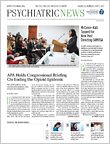Adult Dosages, Titration For Vortioxetine Appear Safe for Children
The same dose range of vortioxetine that is used to treat depression and anxiety in adults appears to be well-tolerated in pediatric patients, according to the results of a multisite study.
The findings, published March 23 in the Journal of Child and Adolescent Psychopharmacology, could be an important first step toward the clinical use of vortioxetine in pediatric depression, noted the study authors.
For the study, researchers divided 24 children and 24 adolescents into groups of six to receive 5 mg, 10 mg, 15 mg, or 20 mg vortioxetine over two weeks, with participants in the three higher doses being titrated up over 2, 4, or 6 days, respectively. All the participants had depression and/or anxiety disorder, and about 40 percent had comorbid attention-deficit/hyperactivity disorder.
The pharmacokinetic analysis showed that blood concentrations of vortioxetine were proportional to dose. The average and maximum blood concentrations of vortioxetine in adolescents were about 30 percent to 40 percent lower at any given dose than the blood concentration of the medication in children.
Vortioxetine was also well tolerated, with study participants reporting only mild side effects, such as headaches and nausea, that were consistent with adverse events previously reported seen in adults.
This analysis was funded by Takeda Pharmaceutical and H. Lundbeck, manufacturers of vortioxetine (Brintillex) .
FDA Approves Home Genetic Test For Alzheimer’s
The Food and Drug Administration (FDA) in April gave its approval to 23andMe Personal Genome Service to market its Genetic Health Risk (GHR) tests. These are the first direct-to-consumer (DTC) tests approved by the FDA that provide information on an individual’s genetic predisposition to certain medical disorders, which may assist people when making lifestyle decisions or serve to inform discussions with their health care providers.
The 23andMe GHR tests use DNA from saliva samples to scan for the presence or absence of selected genetic variants, which have been associated with the risk of disease.
Currently, the tests can provide information for 10 diseases or conditions, including Alzheimer’s disease and Parkinson’s disease. As part of the marketing approval, additional risk tests do not require an extensive premarket review, which means tests for new disorders can be added relatively quickly.
However, the FDA stated that this or future market authorizations do not apply to any diagnostic GHR tests in which the genetic data are strong enough to be the primary guide for a medical decision; the authorization applies only to tests where genetics are one element of an informed discussion.
The other eight conditions included in the GHR tests are celiac disease, alpha-1 antitrypsin deficiency, early-onset primary dystonia, factor XI deficiency, Gaucher disease type 1, glucose-6-phosphate dehydrogenase deficiency, hereditary hemochromatosis, and hereditary thrombophilia.
Potential Bulimia Medication Moves to Phase 2 Trial
Opiant Pharmaceuticals Inc. announced in March that it was initiating a Phase 2 clinical study to evaluate its compound OPNT001 , a nasally delivered opioid antagonist, as a potential treatment for bulimia nervosa.
Currently, the only medication approved by the FDA to treat this serious eating disorder is the antidepressant fluoxetine .
Opiant has had previous success with its opioid-targeting nasal sprays. Its nasal-based naloxone drug, Narcan , was approved by the FDA to treat opioid overdose in 2015.
Opiant hopes to enroll up to 80 patients with bulimia nervosa for the randomized, double-blind phase 2 trial, which will assess OPNT001’s safety and tolerability, as well as changes in eating behavior. The trial will be led by Janet Treasure, Ph.D., a professor of psychiatry at King’s College London.
FDA Approves Handheld VNS Device for Cluster Headaches
The FDA in April approved a handheld, noninvasive vagus nerve stimulator (VNS) for the treatment of pain associated with episodic cluster headache in adult patients, according to a release by electroCore, the makers of the technology.
The device, known as gammaCore, transmits a mild electrical stimulation to the vagus nerve through the skin, resulting in a reduction of pain. According to electroCore, the FDA decision was based in part on the results of two clinical trials, which compared outcomes in patients with episodic cluster headache who received VNS or sham.
One trial of 85 patients with episodic cluster headache found that 34.2 percent of patients experienced a reduction in pain from episodic cluster headache compared with 10.6 percent in patients treated with placebo. A second trial of 27 patients with episodic cluster headache found that a significantly higher percentage of patients using gammaCore reported being “pain-free” within 15 minutes of using the technology at the onset of pain from cluster headache (47.5 percent) versus placebo (6.2 percent). In both trials, gammaCore was found to be safe and well-tolerated, with most adverse events being mild and transient.
Mixed Results for Botox In Depression Trial
A recently completed Phase 2 study of Botox for the treatment of major depressive disorder (MDD) did not find any solid data to suggest it may be effective, but parent company Allergan has decided to still move forward with a Phase 3 trial.
The idea behind using Botox for MDD is that relaxing facial muscles can also relax their corresponding nerves, which are connected to brain regions affected in depression. Some early-stage research had supported this idea.
Allergan’s phase 2 study enrolled 258 women with MDD and compared the effects of either 30 or 50 units of Botox with placebo over the course of six weeks.
By study’s end, participants who received the lower, but not higher, dosage of Botox reported a reduction in symptoms of depression compared with placebo, but these differences were not statistically significant at the six-week mark.
The results of the Phase 3 trial could have significant implications, as Botox is already used off-label for patients with treatment-resistant MDD. ■
